Rhode Island

Perry Raso, Matunuck Oyster Farm, South Kingstown RI
1. Matunuck Oyster Farm, in South Kingstown RI, is owned by Perry Raso who comes across as a humble fisherman but is so accomplished (Masters in Aquaculture), he’s been written up in publications as prestigious as National Geographic. Raso narrates a 1.5-hour tour that brings you by motorized platform boat around Potter Pond, where he and his employees harvest over a million oysters – coveted by top chefs from New York to L.A. – every year. See more of coastal Rhode Island on this Watch Hill and environs post.
VERMONT
2. One of the most unusual aspects of the Southern Vermont Natural History Museum near Wilmington VT, featuring creatures alive and dead, is a focus on albino animals; “red” fox, deer, squirrel, porcupine, woodchuck – and even a live albino California King Snake. On Route 9 on the way to Wilmington VT and Haystack and Mount Snow Ski Areas, this popular stop is just one delightful distraction. Another is the studio and gallery of famous “I Hate Cats” cartoonist, Skip Morrow. Here are many more.
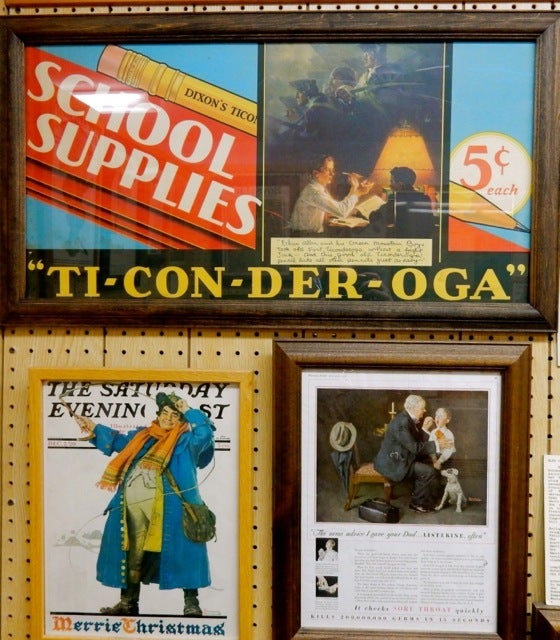
Norman Rockwell Museum, Rutland VT
3. You can purchase an original Norman Rockwell Saturday Evening Post Cover (some with address labels still attached) for as little as $35 at the lesser-known Rutland VT Norman Rockwell Museum (not to be confused with the museum of the same name in Stockbridge MA). While in the Rutland area, find out about other attractions here.
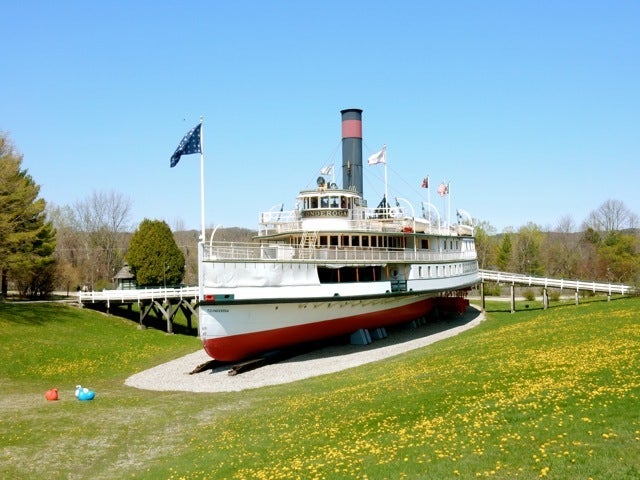
Shelburne Museum, Ticonderoga Steamship, VT
4. A 220 ft. sidewheel steamboat, the Ticonderoga, that once plied Lake Champlain, is on permanent dry dock at the difficult to describe Shelburne Museum near Burlington VT. You’ll need at least three hours (though you can spend a weekend) seeing everything at this 39-building complex comprised of “collections of collections.” In fact, the Shelburne Museum is one of the most unique assemblages of buildings, boats and bridges in one place, all stocked with stuff. Founded by folk-art-collector society dame, Electra Havemeyer Webb, whose family is credited with bringing French Impressionist paintings to New York’s Metropolitan Museum in the 1920’s, and who married James Watson Webb, the son of Eliza Vanderbilt, The Shelburne Museum is as eclectic as Electra was eccentric. She started collecting weathervanes, trade signs, tableware, pewter, sleighs and so much more in 1911, amassing so much that she had to find acreage to house it all. And here it is – plus some. In addition to the museum, you’ll need at least a few days to explore Greater Burlington – get some ideas here.
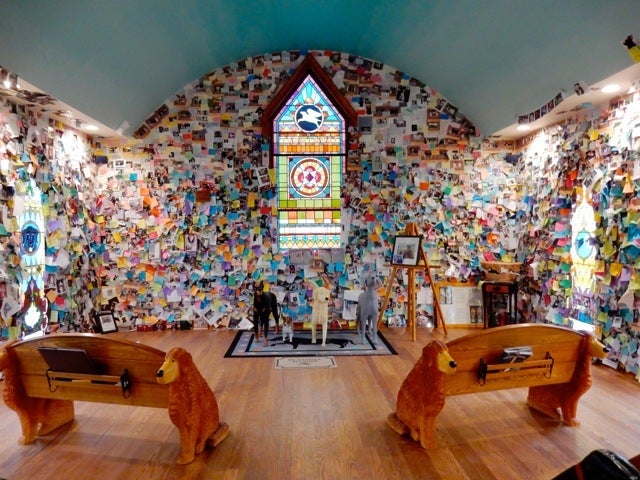
The Dog Chapel, St. Johnsbury VT
5. There are so many quirky elements in the oft-overlooked upper reaches of Vermont, affectionately known as the Northeast Kingdom, or NEK, you’ll just have to read this Offbeat Guide. Suffice it to say, the NEK has Bag Balm, The American Society of Dowsers National Headquarters, a Pet Chapel in which to memorialize (and pray for) your deceased furry and feathery loved ones, the cult-craft-beer favorite, Hill Farmstead Brewery, a Victorian-era Natural History Museum with a brilliant state of art Planetarium, a Maple-Sugar Confectionary business launched by two Columbia University Gal Pals in 1915, and so much more. Weird and wonderful for sure. Click here for more.
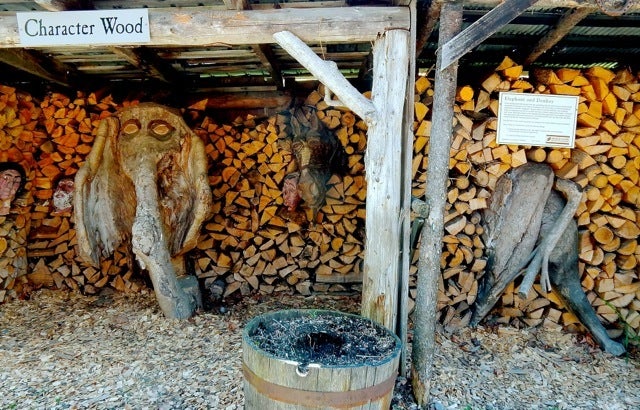
Morse Farm Maple Sugarhouse, Montpelier VT
6. Besides being the tiniest State Capital in the country, Montpelier VT has some outsized characters. “Burr,” the burly owner of Morse Farm Maple Sugarhouse is quick to tell visitors that he’s the 7th generation of Morse’s to be running this enterprise (60 years in this location, “150 years before that down the road”). Burr’s dad was a dairy farmer who hated milking cows. “One day Dad said, ‘I’m getting rid of the critters. I want to start milking people.’” He began making maple syrup and, in 1967, Dad Morse moved the operation closer to the State Capital where he’d be assured of a steady stream of year round tourists. Morse Farm encompasses a store where you can purchase Morse Farm Maple Syrup, watch a sugaring demonstration, buy Vermont’s version of soft-serve ice cream, a Maple Creemee, voted the Best in Vermont, and see some of Burr’s irreverent “tree trunk” sculptures on site; one the head of an elephant and the back end of a donkey. Burr claims he is making no political statement – it’s just how the limbs came together. Find out more to do in Montpelier here.
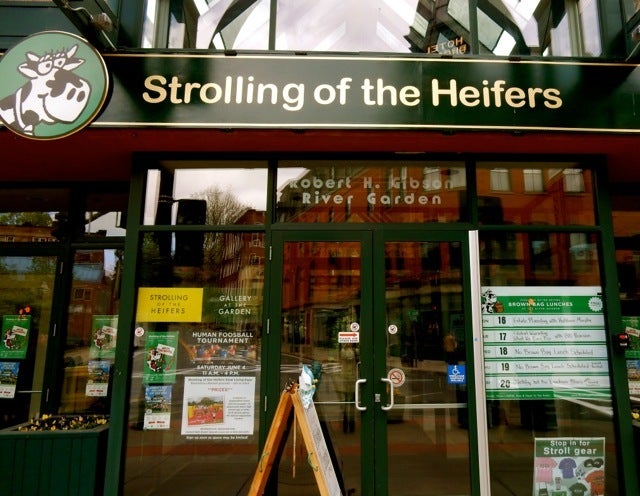
Strolling of the Heifers, Brattleboro VT
7. Spain might have the Running of the Bulls, but Brattleboro VT has the much more chill Strolling of the Heifers, which really, is one fantastic reason to visit. However, there are more.
MAINE

Grave of Mary Nasson, Old York ME
8. Most people flock to Southern Maine for its beaches, but visit the Museums of Old York for some not-for-the-squeamish history at the Old Gaol (jail) and a myth debunked by levelheaded historians. Arguably, the most famous gravesite in the York Village Burial Grounds is the one belonging to Mary Nasson, who died in 1774. Somehow, a legend arose around the slab of stone covering her grave: that it was purposely put there to prevent Mary, thought to be a witch, from rising and causing havoc. York Museum docents and historians stress that these rumors were false in all respects. First of all, witch accusations and trials took place a century before Nasson’s time, and secondly, these horizontal “Wolf Stones,” were often employed in Puritan cemeteries at the time to keep wild animals, pigs and cows from digging up dead bodies. Mary was a well-loved figure in 18th century York and the only rare thing about the grave is her lovely visage carved into her headstone. You can spend hours at the Museums of Old York – each home offers tours and a deep dive into the lives of the families who lived in them. And, of course there are other things to do in Southern Maine – so start with these.
9. The little known but worthwhile Saco Museum in Saco Maine does not turn a blind eye to the more disturbing aspects of the state’s history. In the mid-1800’s, New England towns hummed with industry and all of these cotton mills gave rise to the “Factory Girl;” women who came from abroad or disadvantaged homes to work in droves outside of the home. An influx of immigrants to work the Maine mills produced a hate-fueled backlash, resulting in violence and other forms of bigotry directed towards Blacks, Jews and even French Canadians: by 1925, over 150,000 Mainers belonged to the KKK statewide. Information about the Saco Museum and other things to do nearby in York and the Kennebunks can be found here.
10. L.L.Bean in Freeport ME is open 24 hours a day, 7 days a week, all year long, putting every other retailer on earth to shame.

Peary-MacMillan Arctic Museum, Bowdoin Campus, Brunswick ME
11. The perfect photo op in Bath Maine is right in front of Town Hall, on the corner of Front and Centre Streets. Nearby in Brunswick ME, there’s a museum that very few know about. Most visitors come to Bowdoin College for the Art Museum, never realizing that the Peary-MacMillan Arctic Museum is here. But as eclectic museums go, this one is tops – celebrating the indomitable spirit of world exploration at the dawn of the 20th century, specifically Arctic expeditions conducted by Robert Peary (class of 1877) and Donald MacMillan (class of 1898) who together in 1908 were the first humans to reach the North Pole and record it. Exhibits are full of fascinating trivia, including remnants from a box of Grape Nuts Cereal that MacMillan loved, and items from the Crocker Land Expedition – a failed attempt to find a new arctic landmass, which was proven to be merely an optical illusion. Find out more about the towns on and near the Phippsburg Peninsula here.

Boothbay Railroad Village saltshaker, Boothbay, ME
12. You can see nudie saltshakers, 1920 “Mechanical Parables” – tiny dynamic tin figures that traveled with carnival sideshows - a rare narrow-gauge model train diorama, and a still-in-use 1800’s Town Hall at a Maine attraction many people discount as just a Boothbay ME tourist trap. Oh contraire. The Boothbay Railway Village was opened in 1965 by the still very much alive George McEvoy, a lover of historic preservation who as a kid worked at L.L. Bean during the summer loading catalogs on trains out of the 1912 Freeport Train Station. McEvoy rescued the Freeport Station – the first building to be relocated here, shipped in pieces – to start Maine’s very first railroad museum. There are two-dozen buildings on site, clustered around a narrow-gage railroad track that McEvoy himself installed. But McEvoy was not the only Boothbay Mainer to create a phenomenal local attraction. Take the Maine State Aquarium. This small but fantastic aquarium was the brainchild of educator and biologist, Elaine Jones, who serves as Director. First opened on the fishing docks in 1915, the Aquarium was moved to this bright new building in 1995 after Jones and her husband came up with the design for optimal guest interaction. There’s a touch tank with small sharks that seem to purposefully come to the surface to be petted, and odd creatures caught in commercial fishermen’s nets (they know to call Jones when they find something weird). Be sure to stay for feeding time, when you can witness fish and lobster in small, clear glass tanks munch on lunch. There’s nothing so mesmerizing as watching a lobster methodically stuff raw fish into its strange mouth using smaller, unbanded claws. There’s so much more to do and see in Boothbay ME – start here.
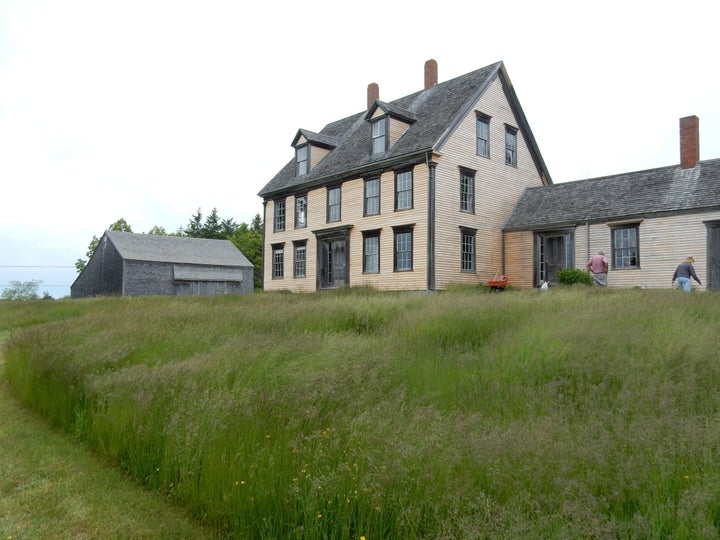
Olson House, ME
13. Every Andrew Wyeth fan should make a pilgrimage to the Olson House in Cushing ME (though you must rsvp first as group tours are limited). The interior of this stabilized ruin of an 1800’s farmhouse is meant to evoke a Wyeth painting, which is precisely the point, as the famous artist set up his summer studio and composed his most famous work of art– Christina’s World (original owned by MoMa in NY) right here. There’s hardly any furniture and the only “art” you’ll find are prints of Wyeth paintings tacked up near the still-life objects they represent. A tour here will reveal the misrepresentations, or “lies,” about Christina Olson and the farmhouse that Wyeth rendered on canvas. And walking the property, far removed from any town, you’ll understand why Wyeth chose to be buried here. Also – nearby in Rockland, the Puffin Project Visitors Center tells the story about how scientists reintroduced endangered puffins back to coastal New England after 100 years. There’s so much more to do and see in Rockland; find out about the best here.
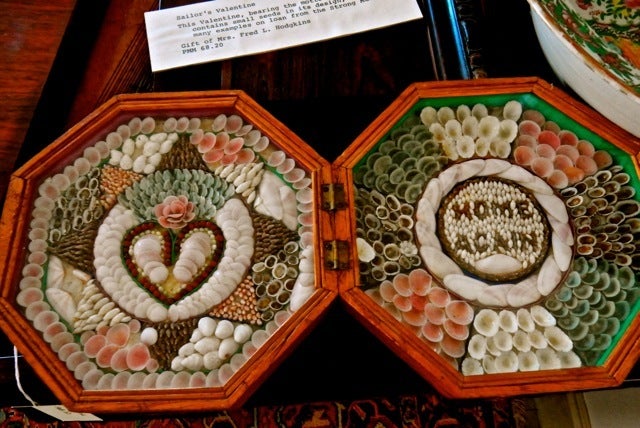
Sailor’s Valentine, Penobscot Marine Museum, Searsport ME
14. Searsport ME was unique during the Whaling Era for its concentration of brave women. This sea-faring town was distinct from others on the New England coast, as most Sea Captain’s wives here (72 documented) accompanied their husbands on their voyages; a rarity when women generally stayed home to raise a family. Many babies were born at sea, so midwives often traveled with these families to assist in births (and then it was off to the next ship and next pregnancy, as the most highly rated midwives were kept very busy). This story is told in the fantastic multi-building Penobscot Marine Museum, where you’ll also find eclectic artifacts and art both heartwarming (a romantic Sailor’s Valentine made from shells) and heartbreaking (an 1840 painting by British Naval officer, E. Poulson, depicting a slave ship getting ready to dump its illegal “cargo” into the sea at the approach of a Royal Navy vessel. Though in miniature, the wide-eyed terror of captured slaves comes through loud and clear). Plan to spend hours here, as each of the many homes and buildings hold treasures. More to see and do in the area can be found here.
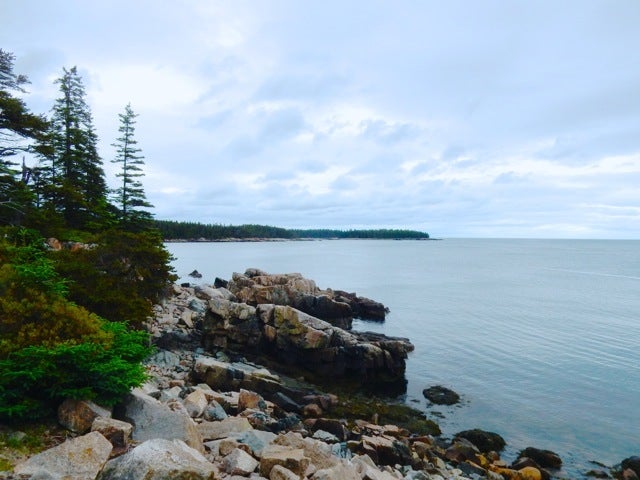
Schoodic Peninsula, ME
15. Do you want to “do” Acadia National Park in Maine but don’t want to deal with the multitudes that converge on Bar Harbor each summer? Then stay on US 1 North about 20 miles from where the crowds veer off, and hook a right onto Route 186 to the next peninsula, Schoodic. Considerably more secluded, the Schoodic Peninsula encompasses 3,500 additional acres of Acadia National Park, with ferry and bus access to the bulk of it on Mount Desert Island. The small Maine towns of Winter Harbor, Birch Harbor and Prospect Harbor are all located on Schoodic, so on this Getaway, you’ll experience nature in its rustic glory, and if you’re game – a few “Pickled Wrinkles.”
